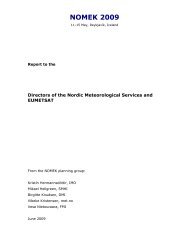International Symposium on Mitigative Measures against Snow ...
International Symposium on Mitigative Measures against Snow ...
International Symposium on Mitigative Measures against Snow ...
Create successful ePaper yourself
Turn your PDF publications into a flip-book with our unique Google optimized e-Paper software.
<str<strong>on</strong>g>Internati<strong>on</strong>al</str<strong>on</strong>g> <str<strong>on</strong>g>Symposium</str<strong>on</strong>g> <strong>on</strong> <strong>Mitigative</strong> <strong>Measures</strong> <strong>against</strong> <strong>Snow</strong> Avalanches<br />
Egilsstaðir, Iceland, March 11–14, 2008<br />
depending <strong>on</strong> lateral positi<strong>on</strong> in the run-out area. Two-dimensi<strong>on</strong>al models do not rely <strong>on</strong> a<br />
single l<strong>on</strong>gitudinal profile, but simulate the flow <strong>on</strong> a three-dimensi<strong>on</strong>al surface representing<br />
the actual landscape. A two-dimensi<strong>on</strong>al model may, thus, be used to compute a twodimensi<strong>on</strong>al<br />
run-out index, which describes the effect of various landscape features <strong>on</strong> the<br />
run-out. One may expect a run-out index of this kind to have a more distinctive shape than<br />
interpolated points of flow-line models indices. The line representing a two-dimensi<strong>on</strong>al runout<br />
index will stretch farther away from the mountain below channels in the topography and<br />
then retreat farther uphill below ridges compared with the corresp<strong>on</strong>ding isoline of run-out<br />
indices al<strong>on</strong>g multiple flow-lines determined by 1D model calculati<strong>on</strong>s.<br />
Identically to the original approach, the two-dimensi<strong>on</strong>al run-out indices are determined by<br />
transferring an avalanche from its original path to the standard path, which has been<br />
transformed to a surface, maintaining the original l<strong>on</strong>gitudinal profile. Figure 1 shows the 3D<br />
standard path.<br />
2.2 Parameter axis<br />
It was c<strong>on</strong>cluded from the experimental simulati<strong>on</strong>s that in order to simulate avalanches that<br />
vary in size it is advisable to change release snow depth, d, and the fricti<strong>on</strong> angle,<br />
δ, simultaneously but keep other model parameters c<strong>on</strong>stant. An important point to c<strong>on</strong>sider is<br />
that a unique backcalculati<strong>on</strong> of the model parameters, d and δ, based <strong>on</strong> informati<strong>on</strong> about<br />
run-out distance solely, is impossible because an infinite number of parameter pairs can<br />
explain a given avalanche run-out. In other words, increased fricti<strong>on</strong>, δ, can be compensated<br />
by an increase in snow depth, d. It is of practical interest to define a single d/δ pair corresp<strong>on</strong>ding<br />
to each run-out index. Similarly to the approach of Jónass<strong>on</strong> and others (1999), a<br />
way to get around this problem has been developed. This is achieved by defining a so called<br />
parameter axis in the d/δ plane <strong>on</strong> which d/δ pairs for simulati<strong>on</strong>s of avalanches with run-out<br />
indices in the range from 10 to 20 are located (Gíslas<strong>on</strong>, 2007). The parameter axis currently<br />
used for systematic two-dimensi<strong>on</strong>al avalanche simulati<strong>on</strong>s at the IMO is plotted <strong>on</strong> Figure 2.<br />
Figure 2 A set of parameter pairs that can be used to simulate avalanches with run-out<br />
indices in the range 10−20.<br />
Gíslas<strong>on</strong> 165











